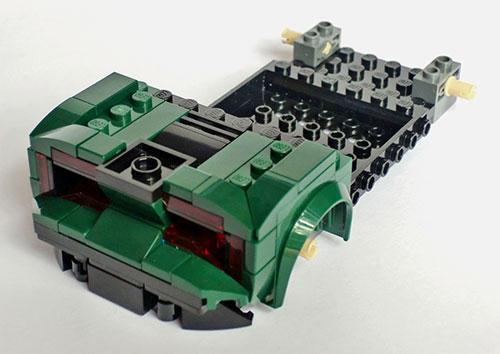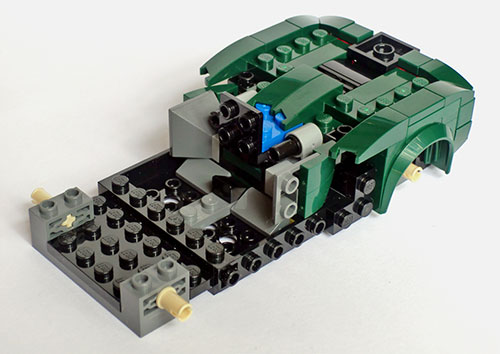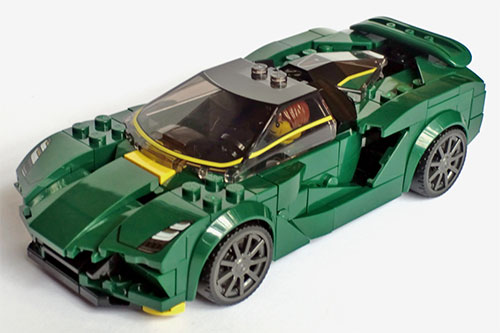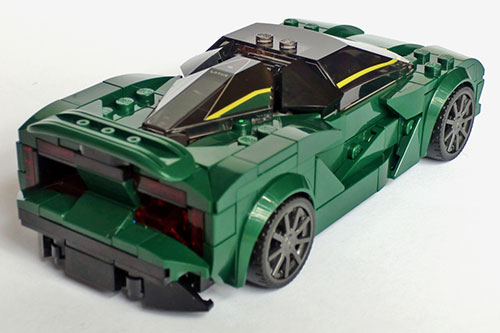Set Review ➟ LEGO® Speed Champions 76907 Lotus Evija

The third and final single-car Speed Champions set for this 2022 wave could have a hard time living up to the standard set by the excellent Lamborghini and Ferrari sets. While it may be less iconic and have less history behind it than the Countach or 512 M, the real car is still very beautifully shaped. Yet its lines are also very curved and flowing, so how well will this translate into brick form? Those yellow stripes on the windscreen also look odd, though product images promise some very interesting tail-light shaping at the back. So let’s get into the build and see what works and what doesn’t.
Box and Contents

The box contains two numbered bags, instructions, sticker sheet, loose chassis part, and a bag of wheel rim inserts. Parts of interest here include two Technic 1x2 modified brick-with-1x2-plate (73109), four Technic 1x1 bricks-with-axle-holes (73230), new left and right 2x3 curved wedge slopes in dark green with headlight printing, the printed front and rear trans-black canopy parts, and of course the dark green snowboard spoiler.
Build Process
The build follows the same order as previously reviewed 2022 sets, with Bag #1 building the driver, chassis, and rear of the car, and Bag #2 building the rest. The driver looks fine in dark green, featuring yellow and silver printing on torso, hips, and legs, and also includes a hairpiece in addition to the helmet. A light bluish grey 2x4 brick added early on (Step 5) will actually be visible from the outside through the side vents, so I would recommend swapping this out to black if you can. A second light bluish grey 2x4 brick is added later (Step 11), making it clear that no engine detail will be included. The real Evija is a fully electric car, with motors located at each wheel hub, but it would have been nice to have something of more interest here under the rear deck.




The build then proceeds to build up the rear diffuser and tail-lights, which is the most interesting part of the model. Brackets and hinge bricks are used here to great effect, hollowing out the rear and accurately shaping the tail lights around the outer edges. These look really good. The diffuser is nicely curved but does rely on stickers to look as it should (93095/23969 modified 1x2 panels would arguably look better here). A pair of #11291 curved wedges are used for the forward part of the rear fenders. These are necessary for shaping the side vents, yet the inboard parts of these pieces limit the detail that can be placed on the rear deck. The curved wedges (66956) behind the cockpit are cleverly locked in place using Technic elements. The hexagonal windscreen used at the rear features some really nice printing, though it relies on surrounding stickers for full effect.
Bag #2 then builds up the door sections and the front of the car. The side studs on some SNOT bricks are used to align the door panels. There is some nice shaping along these side panels, though it isn’t perfect as some studs are unfortunately left exposed. A nice inverted splitter plate section is attached interestingly using mixel ball-joints, and the front bonnet is subtly sloped downwards on a hinge that is cleverly tucked under the recess of another hinge brick. Also nice is the curved top to the dashboard.


Features and Functions
The finished model rolls fine on its wheels, and the cockpit detaches for easy driver access. Everything is quite sturdy, except that the hinged rear windscreen detaches rather easily due to connecting via 1x1 clip tiles. (This connection can be rebuilt much more securely using a SNOT-mounted 1x2 clip plate.) The lack of any engine detail is unfortunate, even if accurate to the real car. I chose to replace the internal 2x4 brick with a silver #50943 engine block, and the angled sides of this part line up very nicely with the trapezoidal tip of the covering windscreen element.
Overall Impressions
A lot of really great design work has gone into this, especially the shaping of the rear lights and side vents. Unfortunately the aesthetics of the model are spoiled by the worst aspect of this set—the absolutely terrible windscreen print design. The yellow striping is supposed to mark the boundary between bodywork and windscreen, yet here they are literally halfway up the side windows. I can only imagine the green/yellow colour scheme was mandated by Lotus, but then hampered by the limitations of printing onto the existing windscreen piece. If so, these stripes may have only worked with a new, more curved mold. In any case, the compromise here doesn’t work at all. Other than that, the model is also a bit angular in all the places where the real car is smoothly curved, but I do think the designer captured the shaping about as well as possible with existing parts.
I have tried improving the model by removing the yellow striping from the cockpit prints. Without this, and without stickers, it was also necessary to remove the four yellow parts at the front. The result is perhaps a little dull in terms of color (the yellow highlights would be great if the print design made more sense), but I do think it looks better than before. Other modifications I can recommend are reshaping the front a little, cleaning up the door panels, and raising the spoiler by half a plate (see picture below).
This set is arguably the weaker of the three 2022 single-car sets, yet there is still a lot to like here. If you’re prepared to put some work into removing the printing then I think the end result is still better than most, if not all, of last year’s 2021 SC cars. Either way, hopefully this review gives a fair overview of what this set has to offer.

Modified set. Some additional parts used.
We wish to thank LEGO for providing this set for review. The opinions in this review are not supported or endorsed by LEGO.
33510